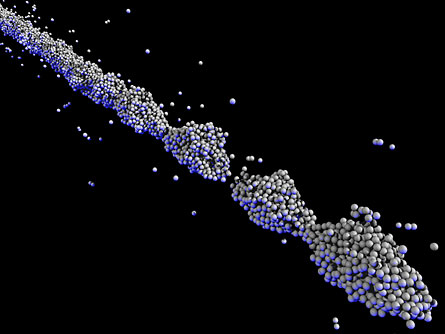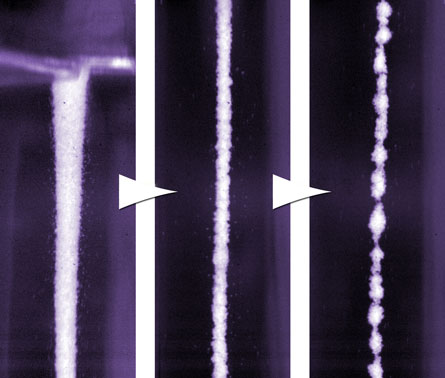- More than 2 years ago
Particles in flowing granular material can cluster like a stream forming droplets as it comes out of a faucet. The clustering is due to attractive forces that create a weak surface tension in grains of glass, scientists report in the June 25 Nature.


Previously, scientists thought grains did not display surface tension, or if they did, the effects were too small to change the flow of the particles. “But this experiment says that if we look very carefully, we find surface tension is almost zero, but it is not exactly zero,” says Heinrich Jaeger of the University of Chicago, an author of the new study.
Clustering is a key problem for transporting powders and granular materials, including fertilizers and pharmaceutical drugs, Jaeger says. Understanding how ultra-low surface tension can cause clusters could help researchers better predict how grains and powders will flow through pipes or even parts of the body, and to know when and whether the material will clump.
“The study shows that even a tiny force between grains can have a really strong effect,” says Xiang Cheng of Cornell University.
To study the clustering, the researchers created a vertical stream of tiny glass beads, each about 100 micrometers in diameter, roughly the width of a human hair. The team dropped an $80,000 high-speed camera in free fall with the glass to capture still pictures of the same three-centimeter-long section of the grain flow. Researchers watched the beads in the stream form into clusters connected by thin bridges, and then into fully separated clusters, in the space of a meter.
Electrically charging the grains had little effect on the stream. Using copper, a less “bouncy” material, made the clusters disappear entirely, suggesting that the forces that absorb energy in collisions are not responsible for the clustering. But making the glass beads smoother with mineral oil made the clustering more pronounced, suggesting cohesion may be the attractive force behind the clustering.
To test the strength of the attractive force between individual grains, the team glued a grain of glass to an atomic force microscope and used the microscope’s scanning needle to bring another grain close to the first one. When the two were pulled apart, the researchers found a small attraction between the grains that could explain the clustering.
Although the force that causes the grains to cluster may be different from the one that causes cohesion in liquids, Jaeger says the fact that granular fluids have surface tension tests the boundaries between liquids and granular fluids. The stream of glass beads “can almost be mistaken for a liquid,” Jaeger says. “So what does it really take to be a liquid?”







